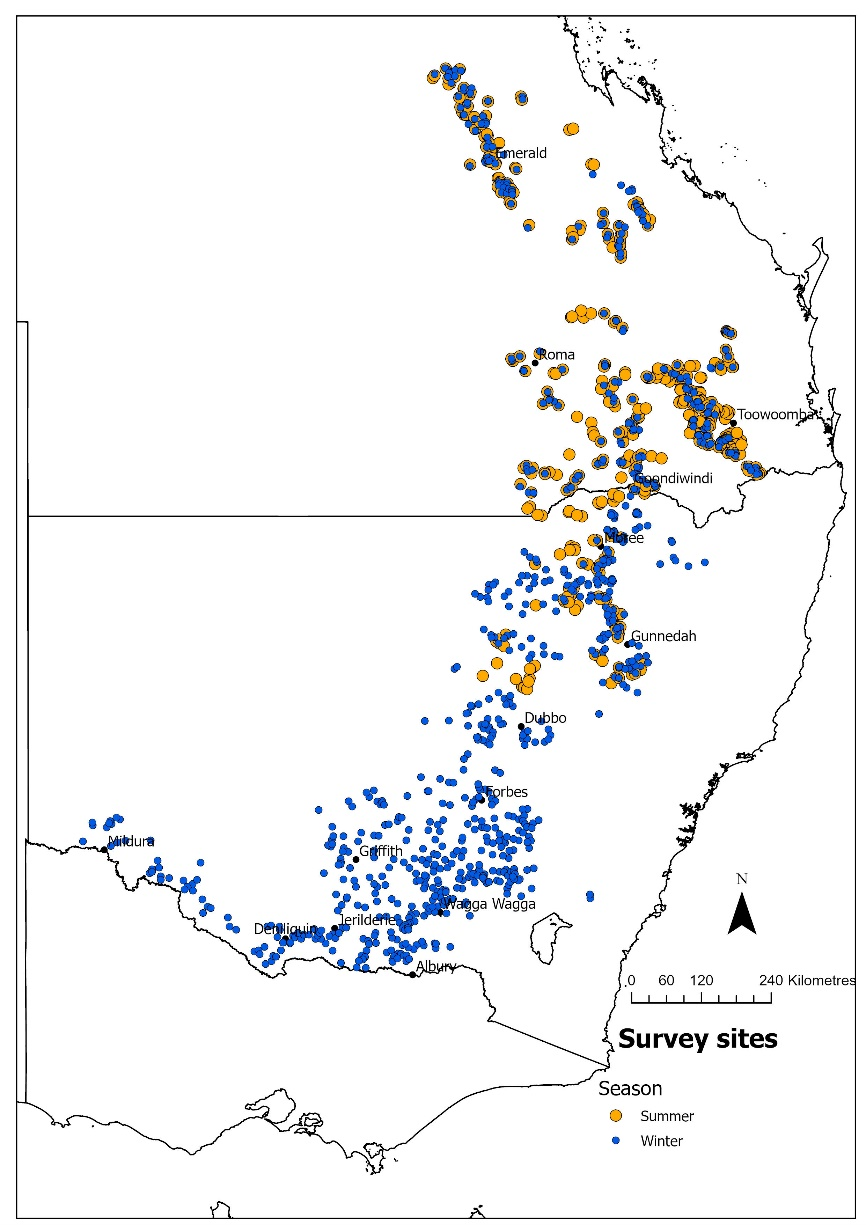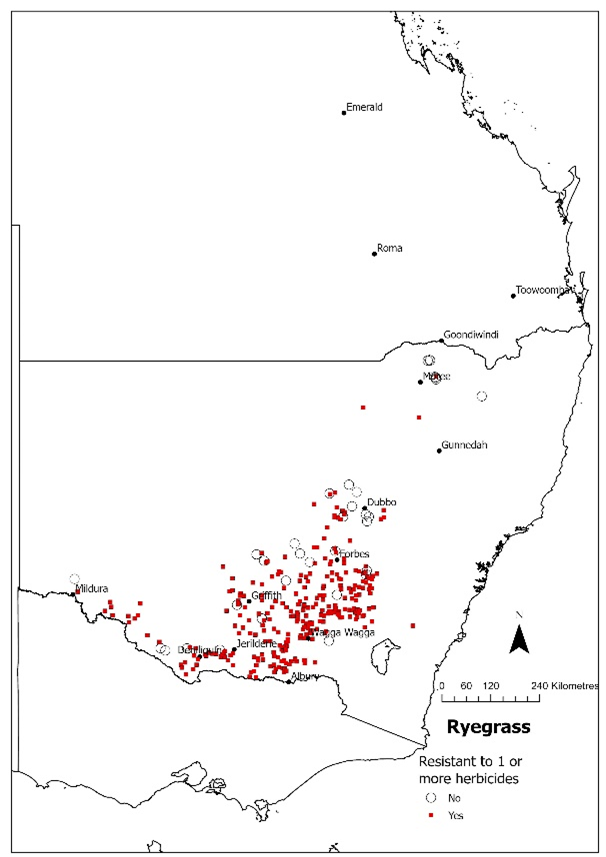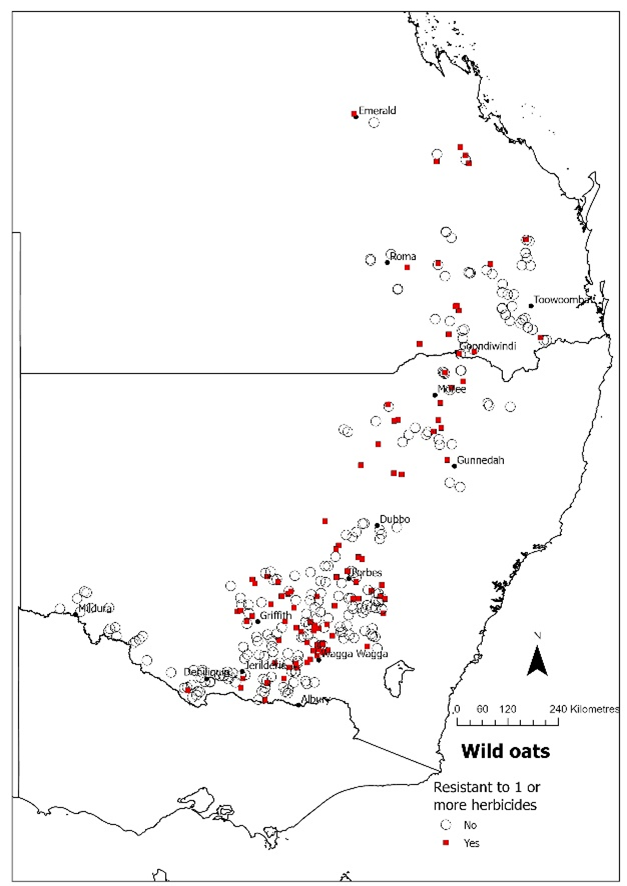Herbicide resistance status of weed species across the cropping regions of New South Wales and Queensland
Author: John Broster (Charles Sturt University), Allison Chambers (Charles Sturt University), Michael Widderick (DAF Qld) | Date: 14 Feb 2024
Take home message
- Resistance to post-emergence herbicides including glyphosate is widespread in the northern grain cropping region with the greatest frequency in southern NSW
- Resistance in ryegrass was only recorded to two pre-emergent herbicides (trifluralin and prosulfocarb + S-metolachlor) and at lower frequency than resistance in ryegrass collected from other Australian states
- Wild oat resistance is more common in NSW and Qld than in populations from other states
- Widespread sulfonylurea resistance was identified in sowthistle populations
Background
Herbicide resistance surveys have been conducted across the Australian grain cropping region for many years with the initial surveys in WA, NSW and Vic conducted to determine the extent of resistance in annual ryegrass in the early 1990’s (Gill 1993; Pratley et al., 1995; Henskens 1997). Subsequently surveys were conducted to determine the level of resistance in wild oats (Pratley et al., 1996; Nietschke 1997). Since then, surveys have been conducted across many sections of the cropping regions at regular intervals looking at many different weed species (Llewellyn and Powles 2001; Walsh et al., 2001; Owen et al., 2007; Broster et al., 2011, 2012; Boutsalis et al., 2014; Owen et al., 2014, 2015a, 2015b). However, it was not until 2016 that every region of the Australian cropping region had been surveyed at least once (Broster et al., 2018).
While all the cropping regions had been surveyed by 2020 each of the organisations undertaking the surveys had used different methods for sample collection, preparation, chemical application, assessment and reporting. In some states, parts of the state were surveyed and screened each year, while in others the entire state was surveyed in a single year with the resistance screening occurring in subsequent years.
The 2020 survey was the first national survey to use a consistent methodology across all these criteria for each species, to the extent that each individual species is screened for resistance at a single location, not at different locations.
This paper presents the results from the winter cropping weed samples obtained from NSW and Qld paddocks during the random field surveys for herbicide resistance conducted in 2020 and 2021 and compares them to the overall survey findings from across Australia.
Results
Samples collected Australia wide
Across Australia 3053 paddocks were visited during the most recent round of surveys, 2688 paddocks with winter crop and 465 (all in NSW or Qld) with summer crop or fallow (Figure 1). From these paddocks the following seed samples were collected; 1486 ryegrass, 677 wild oats, 272 barley grass, 383 brome grass, 581 sowthistle, 136 wild radish, 35 Indian hedge mustard, 124 fleabane, 144 feathertop Rhodes grass, 111 awnless barnyard grass and 27 sweet summer grass.
Samples collected NSW and Qld
From the 878 winter crop paddocks (33% of all winter crop paddocks across Australia) surveyed in NSW (634) and Qld (244) (Figure 1), 337 (23% of total samples) ryegrass samples were collected along with 345 (51%) wild oats, 55 (20%) barley grass, 34 (11%) brome grass, 387 (67%) sowthistle and 27 (20%) wild radish samples. As all of the summer cropping or fallow paddocks surveyed were from NSW or Qld, all of the feathertop Rhodes grass, awnless barnyard grass and sweet summer grass samples collected nationally came from these states. All but two populations of fleabane were from Qld and NSW with two collected from WA as part of their winter survey.

Figure 1. Winter and summer survey sites
Ryegrass
Ryegrass was only found in NSW paddocks with the majority of the samples collected south of Dubbo (southern NSW). Due to previous surveys across Australia finding that 90% plus of samples from most regions were resistant to Group 1 ‘fop’ herbicides, this herbicide sub-group was not tested in samples collected during this survey. While the percentage of samples from southern NSW resistant to each of the post-emergent herbicides was similar to the overall survey findings, the extent of resistance for northern (north of Dubbo) NSW was lower for all herbicides (Table 1). Over 70% of samples from southern NSW were resistant to Group 1 ‘den’ and Group 2 ‘SU’ and ‘Imi’ herbicides compared with less than 50% from northern NSW. About 20% of southern NSW samples were resistant to clethodim (Group 1 ‘dim’) and glyphosate (Group 9) compared with 10% for northern NSW (Table 1).
Resistance to the pre-emergent herbicides was much lower with resistance recorded for only trifluralin (Group 3) and prosulfocarb + S-metolachlor (Group 15) in southern NSW only, and at a lower level than the overall survey (Table 1).
Table 1. Percentage of ryegrass samples from NSW resistant (>20% survivors) to different herbicides compared with the overall survey.
Herbicide | Group | Northern NSW | Southern NSW | Australia (including NSW) |
|---|---|---|---|---|
Clethodim | 1 ‘dim’ | 6 | 19 | 23 |
Pinoxaden | 1 ‘den’ | 26 | 79 | 71 |
Iodosulfuron | 2 ‘SU’ | 44 | 91 | 91 |
Imazamox + Imazapyr | 2 ‘Imi’ | 24 | 73 | 79 |
Glyphosate | 9 | 14 | 24 | 16 |
Paraquat | 22 | 0 | 0 | 0 |
Trifluralin | 3 | 0 | 2 | 12 |
Prosulfocarb + S-metolachlor | 15 | 0 | 1 | 2 |
Pyroxasulfone | 15 | 0 | 0 | 0 |
Propyzamide | 3 | 0 | 0 | 0 |
Cinmethylin | 30 | 0 | 0 | 0 |
Bixlozone | 13 | 0 | 0 | 0 |
Only 6% of the southern NSW ryegrass samples were susceptible to all herbicides, the same as for the overall survey, much lower than the 47% of northern NSW ryegrass samples susceptible to all herbicides (Figure 2).
Figure 2. Ryegrass populations susceptible to all tested herbicides (open circles) or resistant to one or more herbicides (red/darker squares)
Wild oats
Wild oats were found evenly across the entire area surveyed in NSW and Qld and at a greater frequency than in the other states. Fifty percent of national wild oat samples were collected in NSW and Qld from only 33% of all winter crop paddocks visited.
The wild oat resistance to the Group 1 and 0 herbicides was higher in northern NSW than southern NSW, Qld and the overall survey (Table 2). For both southern NSW and Qld the level of resistance for these herbicide groups, while lower than in northern NSW, was also either higher, or similar, to the overall national survey. A significant percentage of the samples from all regions were classed as developing resistance, that is they had plants that survived the herbicide application but at less than 20% (Table 2).
No samples were considered to be resistant (i.e. greater than 20% survivors) to triallate but the seed from some ‘developing resistance’ populations that had surviving plants have been collected for re-testing to see if they survived due to resistance or other reasons.
Table 2. Percentage of wild oat samples from NSW and Qld resistant (>20% survivors) or developing resistance (in brackets; 5-20% surviving plants) to different herbicides compared with the overall survey.
Herbicide | Group | Northern NSW | Southern NSW | Queensland | Australia (including NSW & Qld) |
|---|---|---|---|---|---|
Clodinafop | 1 ‘fop’ | 27 (10) | 25 (20) | 21 (15) | 16 (15) |
Clethodim | 1 ‘dim’ | 2 (0) | 0 (3) | 0 (3) | 0 (1) |
Pinoxaden | 1 ‘den’ | 14 (8) | 9 (22) | 5 (14) | 5 (12) |
Mesosulfuron | 2 ‘SU’ | 0 (9) | 0 (10) | 2 (3) | 1(8) |
Flamprop | 0 | 11 (9) | 6 (23) | 8 (18) | 7 (25) |
Triallate | 15 | 0 (25) | 0 (19) | 0 (16) | 0 (15) |
Thirty three percent of northern NSW wild oat samples were resistant to one or more herbicide groups compared with 29% of southern NSW and 26% of Qld samples (Figure 3). This is higher than the 20% for the overall survey.

Figure 3. Wild oat populations susceptible to all tested herbicides (open circles) or resistant to one or more herbicides (red/darker squares)
Sowthistle
Sowthistle was collected in 387 paddocks across NSW and Qld with 111 of these populations collected during the summer survey from 465 paddocks. The highest incidence of resistance to the sulfonylurea herbicides was in southern NSW with 87% of samples confirmed resistant, compared with 75% in northern NSW, 67% in Qld, and 73% for the whole survey. However, 2,4-D resistance was highest in Qld at 8% of samples compared to 3% in NSW and Australia overall (Table 3). At 5% of populations when combined across the region, this is the first reported incidence of 2,4-D resistance in sowthistle from northern surveys. Of additional concern, a further 33% of populations were rated as developing resistance (1-19% survivors). In this survey no samples were found to be resistant to glyphosate, however a previous 2016-18 survey (Broster et al., 2023) identified 8% glyphosate resistance across the northern region. Further investigations into this are on-going.
Table 3. Percentage of sowthistle samples from NSW and Qld resistant (>20% survivors) to different herbicides compared with the overall survey
Herbicide | Group | Northern NSW | Southern NSW | Queensland | Australia (including NSW & Qld) |
|---|---|---|---|---|---|
Chlorsulfuron | 2 ‘SU’ | 75 | 87 | 67 | 73 |
2,4-D amine | 4 | 3 | 3 | 8 | 3 |
Glyphosate | 9 | 0 | 0 | 0 | 0 |
Note: chlorsulfuron is not registered for control of sowthistle. Chlorsulfuron was included in this screen to check current resistance levels to SU herbicides.
Other species
A small number of other species (barley grass, brome grass and wild radish) were collected from NSW and Qld (wild radish only) during the survey.
All the barley grass and brome grass samples from NSW were susceptible to quizalofop, clethodim, glyphosate, imazamox + imazapyr and paraquat (barley grass only). While all barley grass samples were susceptible to sulfosulfuron, 27% of brome grass populations were resistant to that herbicide. For both paraquat and sulfosulfuron there was one barley grass population with some surviving plants (developing resistance) and three populations (7%) of brome grass were classed as developing resistance to sulfosulfuron.
No wild radish populations from NSW or Qld were resistant to diflufenican (Group 12) although populations from NSW were classed as developing resistance (4 out of 15). Populations from NSW were resistant to chlorsulfuron (5/16) and imazamox + imazapyr (3/14) and developing resistance to 2,4-D amine (6/21) and chlorsulfuron (1/16) while samples from Qld were resistant to 2,4-D amine (1/5) and imazamox + imazapyr (3/4) and developing resistance to 2,4-D amine (3/5) and chlorsulfuron (3/4). Due to limited seed, not all samples were tested to all herbicides.
Future work
Screening of some wild oat populations that required seed increase to have sufficient volume of seed for testing is continuing, as are investigations into glyphosate resistance in sowthistle. A number of wild oat populations with varying levels of survival to clodinafop are also being screened to haloxyfop to check on any similarities or differences in resistance status between Group 1 ‘fop’ herbicides.
References
Boutsalis P, Kleemann SGL, Gill GS, Preston C (2014) A hidden threat: widespread Group B herbicide resistance in brome across south-eastern Australia. In 'Proceedings of the 19th Australasian Weeds Conference' (Ed. M Baker) pp. 202-205. (Tasmanian Weed Society: Hobart, Tasmania, Australia).
Broster JC, Chambers AJ, Jalaludin A, Widderick MJ, Walsh MJ (2018) The extent of herbicide resistance in ryegrass and wild oats in New South Wales and Queensland. In 'Proceedings of the 21st Australasian Weeds Conference' (Eds SB Johnson, LA Weston, H Wu, BA Auld) pp. 145. (Weed Society of New South Wales: Sydney, NSW)
Broster J, Jalaludin A, Widderick M, Chambers A and Walsh M (2023) Herbicide Resistance in Summer Annual Weeds of Australia’s Northern Grains Region. Agronomy 13(7):1862.
Broster JC, Koetz EA, Wu H (2011) Herbicide resistance levels in annual ryegrass (Lolium rigidum Gaud.) in southern New South Wales. Plant Protection Quarterly 26, 22-28.
Broster JC, Koetz EA, Wu H (2012) Herbicide resistance frequencies in ryegrass (Lolium spp.) and other grass species in Tasmania. Plant Protection Quarterly 27, 36-42.
Gill GS (1993) Development of herbicide resistance in annual ryegrass in the cropping belt of Western Australia. In 'Proceedings of the 10th Australian and 14th Asian-Pacific Weeds Conference' pp. 282-285.Brisbane, Qld)
Henskens F (1997) Management of herbicide resistance in ryegrass and other weed species in cropping systems in south-eastern Australia. Project Final Report (DAV-266SR) (GRDC).
Llewellyn RS, Powles SB (2001) High levels of herbicide resistance in rigid ryegrass (Lolium rigidum) in the wheat belt of Western Australia. Weed Technology 15, 242-248.
Nietschke BS (1997) Integrated strategies for wild oat (Avena spp.) management in southern Australian farming systems. PhD thesis, University of Adelaide.
Owen, MJ, Martinez, NJ, Powles, SB (2014a) Multiple herbicide-resistant Lolium rigidum (annual ryegrass) now dominates across the Western Australian grain belt. Weed Research 54, 314-324.Owen MJ, Martinez NJ, Powles SB (2015a) Herbicide resistance in Bromus and Hordeum spp. in the Western Australian grain belt. Crop and Pasture Science 66, 466-473.
Owen MJ, Martinez NJ, Powles SB (2015b) Multiple herbicide-resistant wild radish (Raphanus raphanistrum) populations dominate Western Australian cropping fields. Crop and Pasture Science 66, 1079-1085.
Owen MJ, Walsh MJ, Llewellyn RS, Powles SB (2007) Widespread occurrence of multiple herbicide resistance in Western Australian annual ryegrass (Lolium rigidum) populations. Australian Journal of Agricultural Research 58, 711-718.
Pratley JE, Broster JC, Slater PD (1996) Herbicide resistance in wild oats in southern New South Wales. Project Final Report (UCS-8) (GRDC).
Pratley JE, Leys AR, Graham RJ, Baines PR, Kent JH (1995) The extent of herbicide resistance in annual ryegrass (Lolium rigidum) in southern New South Wales. Project Final Report (UCS-2F) (GRDC).
Walsh MJ, Duane RD, Powles SB (2001) High frequency of chlorsulfuron-resistant wild radish (Raphanus raphanistrum) populations across the Western Australian wheatbelt. Weed Technology 15, 199-203.
Acknowledgements
The research undertaken as part of this project is made possible by the significant contributions of growers through both trial cooperation and the support of the GRDC, the author would like to thank them for their continued support.
Contact details
John Broster
Charles Sturt University, Wagga Wagga
Mobile:0457 272 075
Email: jbroster@csu.edu.au
Date published
February 2024
GRDC Project Code: UCS2008-001RTX,
Was this page helpful?
YOUR FEEDBACK
